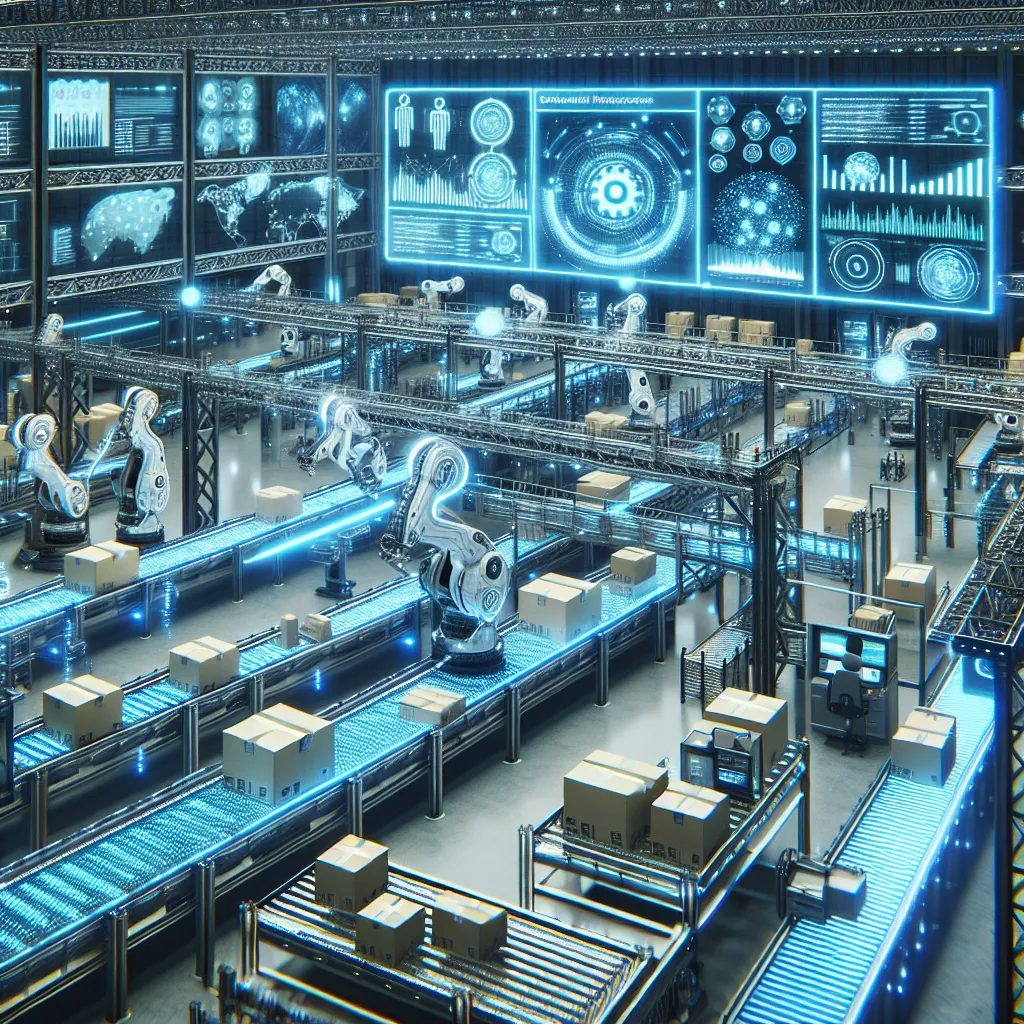As an experienced IELTS instructor, I’m excited to share with you a comprehensive reading practice focused on “The rise of AI-driven automation in global supply chains.” This topic is not only relevant to current technological trends but also provides an excellent opportunity to enhance your reading skills for the IELTS exam. Let’s dive into this engaging practice session!
 AI-driven automation in global supply chains
AI-driven automation in global supply chains
Introduction to the Reading Test
Today’s reading practice will consist of three passages of increasing difficulty, mirroring the structure of the actual IELTS Reading test. Each passage will be followed by a variety of question types to test your comprehension and analytical skills. Remember, time management is crucial in the IELTS Reading test, so try to complete each section within 20 minutes.
Passage 1 (Easy Text): The Basics of AI in Supply Chains
Artificial Intelligence (AI) is revolutionizing the way global supply chains operate. From warehouses to delivery routes, AI-driven automation is enhancing efficiency and reducing costs across the board. This technology is not just about robots in factories; it encompasses sophisticated algorithms that can predict demand, optimize inventory, and even anticipate disruptions before they occur.
One of the key benefits of AI in supply chains is its ability to process vast amounts of data quickly and accurately. This data-driven approach allows companies to make informed decisions in real-time, responding to market changes faster than ever before. For instance, AI can analyze historical sales data, weather patterns, and social media trends to forecast product demand with remarkable precision.
Moreover, AI is transforming warehouse management. Automated guided vehicles (AGVs) and robotic arms can now handle tasks such as picking, packing, and sorting with minimal human intervention. This not only speeds up operations but also reduces errors and workplace injuries.
The implementation of AI in supply chains is not without challenges. Companies must invest in new technologies and retrain their workforce. However, the long-term benefits in terms of efficiency, cost savings, and competitive advantage are driving widespread adoption across industries.
Questions 1-5
Do the following statements agree with the information given in the passage?
Write:
TRUE if the statement agrees with the information
FALSE if the statement contradicts the information
NOT GIVEN if there is no information on this
- AI-driven automation is limited to the use of robots in factories.
- AI can process large amounts of data quickly and accurately.
- Automated guided vehicles can perform tasks without any human supervision.
- Implementing AI in supply chains requires significant initial investment.
- All companies have fully embraced AI in their supply chain operations.
Questions 6-10
Complete the sentences below.
Choose NO MORE THAN TWO WORDS from the passage for each answer.
- AI uses __ __ to predict product demand accurately.
- The use of AI in warehouses can help reduce workplace __.
- Companies need to __ their workforce when implementing AI technologies.
- The long-term benefits of AI implementation include improved __ and cost savings.
- AI-driven automation is being adopted across different __.
Passage 2 (Medium Text): AI’s Impact on Global Logistics
The integration of AI-driven automation in global logistics is reshaping the industry at an unprecedented pace. This technological revolution is not merely about replacing human workers with machines; it’s about creating a symbiotic relationship between human expertise and machine efficiency to optimize the entire supply chain ecosystem.
One of the most significant impacts of AI in logistics is in route optimization. Machine learning algorithms can analyze multiple variables such as traffic patterns, weather conditions, and delivery time windows to determine the most efficient delivery routes. This not only reduces fuel consumption and carbon emissions but also improves delivery times and customer satisfaction.
AI is also playing a crucial role in predictive maintenance for transportation fleets. By analyzing data from sensors embedded in vehicles, AI systems can predict when a vehicle is likely to require maintenance, preventing breakdowns and reducing downtime. This proactive approach to maintenance ensures that logistics operations run smoothly and cost-effectively.
Furthermore, AI-powered chatbots and virtual assistants are transforming customer service in logistics. These systems can handle a wide range of customer inquiries, from tracking shipments to providing estimated delivery times, freeing up human agents to deal with more complex issues. The ability of these AI systems to learn from each interaction means they become more efficient and accurate over time.
However, the rise of AI in logistics also raises important questions about job displacement and data privacy. While AI creates new job opportunities in areas such as data analysis and AI system management, it may also lead to the reduction of traditional roles like warehouse workers and truck drivers. Additionally, the vast amount of data collected and processed by AI systems raises concerns about how this information is stored, used, and protected.
Despite these challenges, the potential benefits of AI in global logistics are too significant to ignore. As the technology continues to evolve, we can expect to see even more innovative applications that will further streamline supply chains and improve the overall efficiency of global trade.
Questions 11-15
Choose the correct letter, A, B, C, or D.
-
According to the passage, the integration of AI in logistics is:
A) Solely focused on replacing human workers
B) Creating a collaborative relationship between humans and machines
C) Only beneficial for large corporations
D) Slowing down the pace of global trade -
AI’s role in route optimization includes analyzing:
A) Only traffic patterns
B) Weather conditions and delivery time windows
C) Multiple variables including traffic, weather, and delivery windows
D) Fuel consumption rates exclusively -
Predictive maintenance powered by AI:
A) Is not yet implemented in transportation fleets
B) Only works for new vehicles
C) Helps prevent breakdowns and reduce downtime
D) Increases the overall cost of vehicle maintenance -
AI-powered chatbots in logistics:
A) Can only track shipments
B) Are less efficient than human agents
C) Handle a wide range of customer inquiries
D) Cannot learn from interactions -
The passage suggests that the implementation of AI in logistics:
A) Has no drawbacks
B) Raises concerns about job displacement and data privacy
C) Is not beneficial for customer service
D) Has been universally accepted without any concerns
Questions 16-20
Complete the summary below.
Choose NO MORE THAN TWO WORDS from the passage for each answer.
AI-driven automation is transforming global logistics in several ways. It optimizes delivery routes, reducing 16__ and improving delivery times. AI also enables 17__ for transportation fleets, which helps prevent unexpected vehicle breakdowns. In customer service, 18__ powered by AI can handle various inquiries, allowing human agents to focus on more complex issues. However, the rise of AI in logistics also raises concerns about 19__ and data privacy. Despite these challenges, the 20__ of AI in global logistics are considered too significant to overlook.
Passage 3 (Hard Text): The Future of AI-Driven Supply Chains
The inexorable march of artificial intelligence (AI) in global supply chains heralds a new era of efficiency, resilience, and sustainability. As we stand on the precipice of this technological revolution, it becomes imperative to examine not only the immediate benefits but also the long-term implications and potential paradigm shifts that AI-driven automation may engender in the global economic landscape.
At the vanguard of this transformation is the concept of cognitive supply chains. These advanced systems leverage machine learning, natural language processing, and computer vision to create self-learning, self-adapting supply networks. Unlike traditional supply chains that operate on predetermined rules and human intervention, cognitive supply chains can autonomously sense, predict, and respond to unforeseen disruptions or opportunities in real-time.
One of the most promising applications of cognitive supply chains is in demand sensing and shaping. By analyzing a vast array of structured and unstructured data – from social media sentiment to geopolitical events – these systems can anticipate shifts in consumer behavior with unprecedented accuracy. This capability not only optimizes inventory levels but also allows companies to proactively influence demand through targeted marketing and dynamic pricing strategies.
Moreover, the integration of blockchain technology with AI-driven supply chains promises to revolutionize transparency and traceability. This symbiosis could create immutable, real-time records of every transaction and movement within the supply chain, effectively eliminating issues of counterfeit goods, ethical sourcing concerns, and opaque supplier networks. The implications for industries ranging from pharmaceuticals to luxury goods are profound, potentially reshaping consumer trust and regulatory compliance.
The advent of edge computing in conjunction with AI is another frontier poised to transform supply chain operations. By processing data closer to its source, edge computing reduces latency and enables real-time decision-making in scenarios where split-second reactions are crucial. This could be particularly transformative in areas such as autonomous vehicle coordination in ports or real-time quality control in manufacturing processes.
However, the path to fully AI-driven supply chains is not without its challenges. The ethical implications of autonomous decision-making systems that can potentially impact human livelihoods must be carefully considered. There is also the question of data sovereignty and the geopolitical tensions that may arise as countries seek to protect and control the flow of data across borders.
Furthermore, the digital divide between large corporations with the resources to implement advanced AI systems and smaller businesses risks creating a two-tiered global economy. This disparity could lead to market consolidation and potentially stifle innovation if not addressed through thoughtful policies and collaborative initiatives.
As we navigate this complex landscape, it becomes clear that the rise of AI-driven automation in global supply chains is not merely a technological shift but a societal one. It demands a holistic approach that considers not only economic efficiency but also social equity, environmental sustainability, and ethical governance. The supply chains of the future will not just move goods more efficiently; they have the potential to become intelligent, adaptive systems that can help address some of humanity’s most pressing challenges.
Questions 21-26
Choose the correct letter, A, B, C, or D.
-
According to the passage, cognitive supply chains:
A) Operate solely on predetermined rules
B) Require constant human intervention
C) Can autonomously adapt to unforeseen situations
D) Are less efficient than traditional supply chains -
The concept of demand sensing and shaping involves:
A) Only analyzing structured data
B) Predicting consumer behavior using various data sources
C) Focusing exclusively on social media sentiment
D) Ignoring geopolitical events -
The integration of blockchain technology with AI-driven supply chains:
A) Has no impact on transparency
B) Increases the risk of counterfeit goods
C) Could eliminate issues of ethical sourcing concerns
D) Is only applicable to the pharmaceutical industry -
Edge computing in supply chains:
A) Increases latency in data processing
B) Is not compatible with AI systems
C) Enables real-time decision-making in critical scenarios
D) Is only useful for quality control in manufacturing -
The passage suggests that the implementation of AI-driven supply chains:
A) Has no ethical implications
B) May create a digital divide between large and small businesses
C) Will definitely stifle innovation
D) Is equally accessible to all companies regardless of size -
The author’s stance on AI-driven automation in global supply chains is:
A) Entirely negative
B) Purely optimistic without any reservations
C) Balanced, acknowledging both benefits and challenges
D) Indifferent to its potential impact
Questions 27-30
Complete the summary below.
Choose NO MORE THAN THREE WORDS from the passage for each answer.
The rise of AI-driven automation in global supply chains represents a significant technological advancement with far-reaching implications. Cognitive supply chains utilize various AI technologies to create 27__ that can adapt to changes autonomously. These systems excel in 28__, allowing companies to anticipate and influence consumer behavior. The integration of blockchain technology promises to enhance 29__ in supply chains, addressing issues such as counterfeit goods. However, the implementation of these advanced systems also raises concerns about 30__ and the potential for creating a divided global economy.
Answer Key
Passage 1
- FALSE
- TRUE
- FALSE
- TRUE
- NOT GIVEN
- historical sales
- injuries
- retrain
- efficiency
- industries
Passage 2
- B
- C
- C
- C
- B
- fuel consumption
- predictive maintenance
- chatbots
- job displacement
- potential benefits
Passage 3
- C
- B
- C
- C
- B
- C
- self-learning, self-adapting supply networks
- demand sensing and shaping
- transparency and traceability
- ethical implications
Conclusion
This IELTS Reading practice test on “The rise of AI-driven automation in global supply chains” has provided you with a comprehensive exploration of this cutting-edge topic. By engaging with these passages and questions, you’ve not only enhanced your reading skills but also gained valuable insights into how AI is transforming global industries.
Remember, success in the IELTS Reading test comes from regular practice and familiarizing yourself with various question types. As you continue your IELTS preparation, consider exploring related topics such as the impact of automation on transportation and logistics and how automation is transforming global manufacturing processes. These will further broaden your understanding of technological advancements and their global impact.
Keep practicing, stay curious, and approach each reading passage as an opportunity to learn something new. Good luck with your IELTS preparation!


